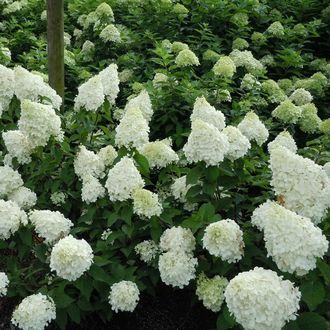Content
Common anemone, or common lumbago (A. pulsatilla)
Like many anemone, lumbago belongs to the adorable primroses. It blooms in early spring (before the appearance of a rosette of carved basal leaves) with single large flowers-bells of purple, white or red, crowning an erect stem about 15 cm high.
In spring, on the sunny edges of the forest or under the lacy shade of trees, you can still find beautiful overgrown lumbago curtains with an abundance of pale blue or blue-violet flowers. But there is no need to dig out these plants, which have already become very rare, they have fragile roots and do not tolerate transplantation very well. Better to collect numerous sleep grass seeds and scatter them throughout the forest, and at the same time sow in your garden.
Lumbago loves loose, calcareous, nutritious soil. Sprinkle the seeds lightly with light soil; shade tender shoots for the first time and water in the heat.
In the first winter, it is advisable to cover young plants with dry sawdust or spruce branches. The flowering of the sown lumbago will have to wait two years, but it will gradually grow and delight with its flowering for many, many years, while not requiring any care.
Anemone tender (A. blanda)
Small dry nodules of tender anemones, equipped with spectacular pictures, can be found in flower shops in autumn and spring. This anemone has many advantages, but, alas, several serious disadvantages. The advantages include very delicate chamomile flowers - blue, white or pink. Flowers of the tender anemone appear simultaneously with the leaves in April, almost immediately from under the snow.
These miniature plants, not exceeding 5-10 cm in height, usually bloom for 2-3 weeks - until about mid-May. By the end of May, the leaves of the anemone begin to wither, and in June they completely disappear. That is why the ideal place for this species is the areas around large perennials, which begin to grow only by the end of May. Anemone tender will suit almost any soil with good drainage and a little sand. She prefers sunny areas or partial shade.
There are usually three varieties on sale: Blue Shades (blue), White Splendor (white), Charmer (pink). Now about the disadvantages of tender anemone. In fact, there is one drawback, but very significant: the purchased nodules of this anemones are very difficult to force to germinate. Even despite soaking in water (for 1-2 hours) immediately before planting, out of 10 nodules, at best, 2-3 pieces germinate (and sometimes not a single nodule!). The best results are obtained not in spring, but in autumn planting of tender anemones (in this case, it is not necessary to soak the nodules before planting). But if the nodules have sprouted, then you can forget about them for many years! Every year anemones will grow more and more, and in a few years even a single plant will turn into a flower rug.
These anemones are quite hardy, practically not affected by any diseases and are very unpretentious. If someone you know has tender anemones already growing, ask them for a few nodules (the best time for transplanting is the yellowing stage of the leaves) and immediately plant them in your garden.Just be sure to fence off the nodule planting site with pegs or stones, so as not to accidentally dig up the anemones in the fall!
Popular varieties of tender anemones:
• ‘Blue Shades’, ‘Blue Shades’ - the flowers are blue;
• ‘Charmer’ (‘Charmer’) - this garden form is characterized by a dark pink color of flowers;
• ‘Pink Star’, ‘Pink Star’ - lavender-pink flowers;
• ‘Radar’ (‘Radar’) - pleasant garden form: purple-red flowers with a bright white center;
• ‘Rosea’, ‘Pink’ (‘Rosea’) - this cultural variation has cyclamen-red flowers;
• ‘Violet Star’, ‘Violet Star’ (‘Violet Star’) - the middle of the flower is white, and the color of the tepals is amethyst-purple.
Crown anemone (A. coronaria)
Another type of anemone that reproduces mainly tuberous segments of the rhizome. Pictures with these anemones usually amaze the imagination of novice florists. And, alas, it is after not too successful acquaintance with them that conclusions are often drawn about the terrible capriciousness of all anemones in general. But first, let's remember the advantages of this species. The crown anemone is the recognized queen among the whole genus of anemone. It has the largest (up to 8 cm in diameter) and bright flowers of various colors and shades (blue, white, red, pink, crimson). Its terry forms are very effective. But this is where the advantages of crown anemones end.
The fact is that this species is native to the Mediterranean, and therefore, in the conditions of the middle lane, it winters extremely unstably and blooms rather modestly. If in the south its bushes reach a height of 45 cm, then in our country they do not exceed 15-20 cm.
Sometimes this type of anemone is recommended to be dug up for the winter, but in this case (as well as during spring planting in general), the plant's habitual development cycle is completely lost. Under natural conditions (with autumn planting or without digging out for the winter), the crown anemone blooms in late May-early June, in summer its leaves completely die off, and in early autumn, flowering (albeit less abundant) is repeated again. When planting in spring, this anemone blooms (and somehow very inexpressively) only by the middle of summer, then it begins to turn yellow, and the repeated autumn flowering coincides with the first snow and severe frosts.
And this despite the fact that the crown anemone has the same drawback as the previous species: its tubers, even after several hours of soaking, germinate very poorly. But if all of the above did not scare you off, and you nevertheless decided to try to grow these flowers, keep in mind that they need a sunny location, fertile soil with the addition of sand and with good drainage.
The most common for cutting is a tall variety of crown anemone `Mona Lisa` (in cutting it costs up to 15 days), there are double varieties.
Groups and varieties of crown anemones:
• St. Brigid Mixed (Double) - up to 30-40 cm high, double and semi-double flowers, of various colors:
• ‘Admiral’ - raspberry purple;
• ‘Lord Lieutenant’ - dark blue;
• ‘Mount Everest’ - white;
• Mr. Fokker '- lilac (violet-blue);
• ‘The Governor’ - red with a white center;
• DeCaen Mixed - up to 30-40 cm high, flowers are simple, of various colors:
• ‘Bicolor’ - white with red edging at the center;
• ‘Hollandia’ - red with a white center;
• ‘Sylphide’ - raspberry (purple-pink).
Anemone oak, or white (A. nemoroza)
This anemone is still less popular with us than the previous two. The oak anemone reproduces by seeds (which quickly lose their germination) and by dividing the bush. Unfortunately, I have not yet met either its seeds or adult plants in pots, so I will have to look for this plant from florists. However, you can, if you wish, find it in the forest. After all, the homeland of this species is the forests of the European part of Russia. The oak anemone blooms in spring for 3-4 weeks (from late April to mid-May). The height of her bush does not exceed 20-30 cm, and the diameter of the flower is 2-3.5 cm.More often, the oak anemone is found with simple white flowers, although its varieties are bred with lilac, blue, pink flowers, simple and double.
In June, the leaves of this species of anemone begin to gradually turn yellow, and at the beginning of July they completely die off.
The oak anemone has a very long branched rhizome, which grows rapidly. As a result, this species quickly forms real thickets. In addition, if you do not pick off the faded flowers, then the seeds ripen, which the next year give abundant self-seeding.
Vitality and unpretentiousness are the main advantages of oak anemones. For successful development, they need loose, moist soil (preferably with the addition of lime) and a shady or semi-shady place.
Popular varieties of oak anemone or oak anemone:
• ‘Alba Plena’ - a flower with a double perianth of white color;
• ‘Vestal’ - snow-white flowers, double, slightly larger than the previous variety;
• ‘Allenii’ is a little-known garden form with light blue petals with a pink tint;
• ‘Robinsoniana’ - the cultivar blooms with bright lilac flowers.
More than 50 different varieties of oak anemone are on sale in Europe, unfortunately, in our country their choice is limited to 3-4 varieties.
European varieties of oak anemones:
• Anemone nemorosa ‘Lucy’s Wood’ is a wonderful, profusely flowering anemone with white flowers, with a slight purple tint.
Buttercup anemone (A. ranunculoides)
This is another early spring and extremely unpretentious anemone from the forests of the European part of Russia. Alas, I have not yet come across it on sale either in the form of seeds or in the form of adult plants. So it might be worth looking in the woods too! This type of anemone blooms in early May (within 2-3 weeks) with bright yellow flowers with a diameter of 1.5-3 cm. Its varieties with double flowers are bred. The height of the bushes does not exceed 20-25 cm. Just like the oak anemone, the leaves of the buttercup anemone completely die off by the beginning of July. These plants also thrive very well thanks to the creeping rhizome.
Buttercup anemone grows on almost any soil and prefers shady corners of the garden.
Forest anemone (A. sylvestris)
This anemone, both in appearance and in life cycle, is very different from previous species. Forest anemone is a plant 25-50 cm high, with rather large (3-5 cm in diameter) slightly drooping white flowers. There are also varieties of it with double and larger (up to 8 cm) flowers. Flowers appear in late May-early June and decorate the garden for 15-25 days (in the shade, the plant blooms longer than in the sun). The forest anemone grows best on loose, light soils with the addition of lime. It grows very quickly, forming a green cushion of leaves that remain green throughout the season. The forest anemone reproduces by seeds and dividing the bush. You can easily find in stores and its seeds, and adult plants in pots (in large garden centers). For germination, seeds need stratification - keeping them wet for 2-3 months at a temperature of 2-3C (for example, in a refrigerator).
Anemone hybrid (A. hibrida)
It is the only type of anemone that blooms in late summer and even autumn. That is why the hybrid anemone is often called the autumn anemone. It also has other names derived from its natural forms, the ancestors of the species: Japanese, Hubei and grape-leaved.
This type of anemone can be found commercially. There are both its seeds (usually from foreign companies) and rhizomes or even ready-made plants in pots. Its seeds also require stratification for germination. The hybrid anemone is a very tall plant (up to 1.2 m), which grows rather quickly thanks to its numerous root suckers. Its leaves appear rather late in spring (mid-May) and remain green until severe autumn frosts. Since the hybrid anemone has a huge number of varieties, it is very difficult to unequivocally determine the time of its flowering. The early varieties bloom in mid-July, while the later ones stop blooming at the end of September.The average duration of flowering of each variety of hybrid anemones is 35-40 days. The diameter of the flowers ranges from 5 to 8 cm, and their shades range from white and pale pink to purple-red. In addition, elegant terry varieties have been bred. But the hybrid anemone has one significant drawback - its insufficient frost resistance. That is why it is better to transplant this plant in the spring. When planted in autumn, the hybrid anemone will almost certainly freeze out.
It is better not to disturb this anemone without special need! Young specimens require mandatory shelter for the winter (dry leaves or spruce branches). Adult plants are more winter-hardy, but in severe winters with little snow they can freeze out too. Ideal conditions for the growth of hybrid anemones are partial shade and loose, fertile, moist soil.
Japanese anemone (A. japonica)
The bush is about 40 cm high. The leaves are dark, the colors of the buds are pale or richly bright. The palette of shades is quite wide. The buds are collected in groups in loose inflorescences.
Udi anemone (Anemone udensis)
Low, no higher than 10-20 cm, a plant with a thin creeping rhizome. The leaves are three-dissected, the peduncles are single, thin, sinuous, bear one white flower 2-3.5 cm in diameter. This anemone blooms later than the others, in the second half of May, for 18-20 days.
Anemone of the Apennine (Anemone apennina L.)
Homeland - Southern Europe, the Balkans. Perennial herbaceous plants about 15 cm in height. The rhizome is powerful, short-creeping, almost round. Flowering stems are erect, thin. Basal leaves on long petioles, tripartite almost to the base, their segments sessile, lateral segments bipartite to the base, apical segments trilobate or triple incised, dentate along the edge, glabrous. Stem leaves, 3 in number, whorled, compound, trifoliate, irregularly and unevenly incised along the edge from lobed to deeply dissected. The terminal lobes (segments) are lanceolate, pointed, whole along the edge or with single teeth, on long petioles. The flowers are pale blue, solitary, apical, 2.5-3 cm in diameter, hairy, 2-3 cm long on pedicels. Tepals, 10-18 in number, oblong, obtuse, hairy at the base. Blooms in April-May. Most decorative in partial shade, where flowers retain their color longer. Hardy to minus 23 ° C. In culture since 1575. Highly decorative. Widespread in Europe, it has many decorative forms and varieties. Varieties differ in color of flowers and terry.
Caucasian anemone (Anemone ca-ucasica)
Anemone with large blue flowers. The plant usually barely reaches a height of 20 cm, blooms in April-May. Grows well in dry, open places.
Spring anemone (Anemone eranthoides)
It is a stunted plant. Blooms in March-April. Creamy yellow flowers with a diameter of 1-3 cm appear from red-brown buds, located on the stems in pairs.
This miniature plant, about 20 cm tall, prefers humus-rich soil and diffused sunlight.
Garden anemone (Anemone hortensis)
Flowers up to 5 cm in diameter, with red, pink or whitish with purple stamens. The plant blooms in early spring, its height is 15-30 cm. It has a pronounced dormant period in summer. The plant is not very hardy, therefore it requires strong insulation with a dry leaf for the winter.
Blue anemone (Anemone caerulea)
Originally from the Sayan Mountains and the south of Western Siberia. It also blooms in mid-May and blooms for two to three weeks. It also has a creeping horizontal rhizome, but the plant forms not dense, but looser clumps up to 20 cm high. For 3-4 years, its area can grow up to 30-40 cm in diameter. Straight peduncles bear at the end three carved palmate leaves and a single pale blue or white flower 1.5–2 cm in diameter.
Rock anemone (Anemone rupestris)
It is still rare in amateur gardens. This very beautiful species comes from the Himalayas, where it grows at an altitude of 2500–3500 m among shrubs and grasses.The experience of growing in the suburbs has shown that the rock anemone is unpretentious and easy to care for. The root system is a bunch of roots that penetrate the soil to a depth of 15 cm. From mid-May, purple peduncles 20-30 cm long appear from the rosettes. Each has up to three large flowers. On the back of the snow-white petals, there is an intense bloom of an inky purple color. Flowering lasts about a month. And then aerial stolons begin to grow, at the ends of which young rosettes are formed. However, this species does not grow very actively.
Anemone lipciensis (Anemone x lipsiensis).
The varieties are few in number and much less popular than the oak anemone varieties. Meanwhile, it is a magnificent, unpretentious plant with a good growth rate. The flowers are of a pleasant warm creamy yellow hue, contrast very beautifully with the dark rich green of the leaves.
• Schwefelfeuer - light yellow delicate flowers, thick beautiful curtain. Growing fast.
• Sioux - semi-double flowers, medium size. Grows at a moderate rate.
Much less common in gardens are anemones, common in the forests of eastern Russia - Amur anemone (Anemone amurensis), Kamchatka anemone (Anemone amurensis ssp. Camtchatica), Altai anemone (Anemone altaica). Outwardly, they resemble an oak anemone and are more interesting to collectors.
Altai anemone (Anemone altaica Fisch.ex C. A. Meu)
Homeland - the European part of Russia, the south of Western Siberia and the southwest of Eastern Siberia, Japan. Plant of coniferous and deciduous forests.
A spring-flowering plant with a horizontal, thickened, cylindrical rhizome. Stem leaves are tripartite with oblong toothed lobes. Peduncles are hairy, solitary, up to 15 cm tall. The flowers are white, sometimes the outer side of the petals with a purple tint, up to 4-5 cm in diameter, with numerous, 8-12, petals. Blooms in April - May 15-20 days. Forms fruits in July, the fruit is a pubescent achene with a curved nose. Shaded areas are required for good development.
Anemone smooth(Anemone glabrata)
Plant of wet forest glades of the Far East.
From long branching thin rhizomes, low stems 6-25 cm long extend. Basal leaves on petioles are rounded in outline, three-dissected to the base. Their lobes are widerhombic, adjoining edges, without petioles. The leaves are elliptical, tapered. 1-2 peduncles with single white flowers with a diameter of 1.5-2.5 cm depart from the veil. There are five perianth leaves, they are almost rounded. This anemone blooms at the end of April, does not tie seeds.
Anemone udskaya (Anemone udensis)
It stands apart among the Far Eastern anemones - it is interesting not so much for its flowering as for the remarkable shape of the leaves, the density of the curtain and the desire to actively capture the surrounding space, creating a low beautiful carpet, decorated in May with medium-sized snow-white flowers. At the same time, the plant does not require any maintenance at all.
Hubei anemone (Anemone hupehensis)
Plant height 50 - 90 cm. Flowers are smaller than that of Japanese anemone, appear in August-September.
Popular varieties:
• ‘Rhaesokh’ - red-pink;
• ‘Splendens’ - red;
• ‘Septembercharm’ - pink.
Felt anemone (Anemone tomentosa)
Has deeply dissected leaves. It grows up to 120 cm and blooms from August to September. Among other autumn anemones, this is the most hardy and cold-resistant species.
The most famous variety is 'Robustissima' - light pink.
Grape-leaved anemone (Anemone vitifolia)
Simple white flowers bloom from August to October. This species, unfortunately, is rarely found on the market.
Leinzig anemone or average, or Zeemann (A. x lipsiensis = A. x intermedia = A. x seemannii)
The species appeared as a result of natural hybridization of anemone (A. nemorosa) and buttercup (A. ranunculoides). Like the parent species, the Leipzig anemone is miniature, prefers shady places and blooms in early spring.Its trifoliate, deeply dissected leaves, growing from a smooth brown rhizome, die off immediately after the flowers wilt. Single flowers are light yellow in color and cylindrical in shape. The perianth, 2 cm in diameter, consists of 6-8 leaves. This plant can be cultivated in normal fertile garden soil.
Long-haired anemone (Anemone crinita Juz)
In nature, it grows in Western Siberia (Ancharsky region), in Eastern Siberia (Angara-Sayan and Daursky regions). It grows in light coniferous and deciduous forests, along the edges, in thickets of shrubs, in meadows, in the mountains, in forest and subalpine meadows, less often in mountain tundra.
It has a straight short thick rhizome, covered with abundant roots. From it departs a powerful erect, densely drooping stem 12-45 cm high. Root leaves on long petioles, covered with silky hairs. Their plate is rounded in outline, five-cut, with wide lobes. The leaves are covered with large, similar to basal, with long hairs below. Peduncles emerge from the bedspread in 3-5, they are densely pubescent. The flowers are large, 2-4 cm in diameter, collected in terminal umbellate inflorescences. Tepals are elliptical white. Blooms in May - June 25-30 days. It differs from the daffodil anemone by large pubescence and, accordingly, is more drought-resistant. Prefers a sunny location, but can tolerate light shade.
For medicinal purposes, a herb is used (stems, leaves, flowers).
Flavonoids are found in the roots. In the aerial part, oil, transaconite organic acid, alkaloids, flavonoids were found. In the stems and leaves - traces of alkaloids, flavonoids. Flowers contain flavonoids. An infusion of herbs in Tibetan medicine is used for visual and hearing impairment. An infusion, a decoction of herbs Mongolian medicine uses as a tonic of the central nervous system, fortifying, stimulating metabolism, in case of food poisoning, poisons, and snake bites.
Possesses antibacterial properties. Infusion of flowers is used to treat injuries and purulent wounds.
Beam anemone, or daffodil (Anemone fasciculata L. = A. narcissiflora L.)
Grows wildly in the Caucasus on a limestone substrate, where in summer it forms whole blooming fields. Found in Central and Southern Europe and the mountains of North America.
Perennial plant up to 30-60 cm tall with a thick vertical rhizome and a mass of fibrous roots. Finger-dissected leaves. Above the rosette of beautiful light green pubescent, finger-dissected leaves, numerous peduncles rise, from 3 to 8, ending in an umbrella-shaped inflorescence of white or pinkish small flowers up to 2.5 cm in diameter.
Blooms in Moscow in late May - early June, blooms for a long time, up to 30 days, and abundantly. In June, seeds ripen, which, when sown before winter, form abundant shoots in the spring. But seedlings develop for a long time and bloom only for 4-6 years. Propagated by dividing the bush in late summer or early spring and freshly harvested seeds. It grows especially well in sunny places with loose, drained, neutral soils. The plant is cold-resistant, resistant. Looks great in mixborders. One of the best among the wild species of these wonderful perennial plants. Although she is tall, she looks very impressive on the mountain lawn.
Forked anemone
Perennial herb, 30-80 cm high with a thin black-brown rhizome. Stem erect, Leaves are opposite, sessile, deeply 3-partite with oblong or broad-lanceolate lobes. The leaves are adpressed at the edges and on the underside. Flowers are solitary on long peduncles 2-3 cm in diameter. Tepals 5 elliptical, white, sometimes reddish below. Squeezed fruits.
Blooms in June and July.
It is found in the European part of Russia (Volzhsko-Kamsky, Zavolzhsky regions), in Western Siberia (Obsky, Irtyshsky, Altai regions), in Eastern Siberia (all regions), in the Far East of Russia (all regions).It grows in flooded and damp meadows, grassy swamps, damp shrub thickets and sparse forests.
For medicinal purposes, the herb (stems, leaves, flowers), harvested during flowering, and roots are used. The plant contains essential oils 0.2%, cardenolides, saponins, alkaloids, flavonoids, gamma-lactone, vitamin C. Fatty oil of 6.87% was found in the fruits.
A decoction of the herb in Tibetan medicine is used for heart disease, hearing and visual impairment. An infusion of herbs is drunk with noise in the ears, insomnia; externally - for fungal skin diseases, erysipelas, and throat diseases. Has a hypotensive effect. In China, a decoction of 3-6 grams of roots is used for diarrhea, carbuncle intoxication. Outwardly, in the form of a decoction from an arbitrary number of roots, it is used as a compress for various kinds of injuries.
In addition to the already listed anemones, no less beautiful other species grow well in the middle lane. But, unfortunately, they are practically not found in our gardens, and it is still unlikely to find their planting material in stores.
Anemone acutiloba
Anemone albana - Albanian backache
Anemone alpina
Anemone ambigua - Doubtful lumbago
Anemone americana
Anemone angulosa
Anemone baldensis
Anemone begoniifolia
Anemone biflora
Anemone bungeana - Backache Bunge
Anemone canadensis
Anemone caroliniana
Anemone cernua - drooping lumbago
Anemone chinensis - Chinese backache
Anemone cylindrica
Anemone dahurica - Daurian backache
Anemone davidii
Anemone decapetala
Anemone deltoidea
Anemone dermissa
Anemone drummondii
Anemone flaccida - Flexible anemone
Anemone × fulgens
Anemone glaucifolia
Anemone halleri - Haller's backache
Anemone helleborifolia
Anemone × hybrida
Anemone jenisseensis - Yenisei anemone
Anemone lyallii
Anemone mexicana
Anemone montana - Mountain lumbago
Anemone multifida
Anemone nikoensis
Anemone occidentalis
Anemone parviflora - Small-flowered anemone
Anemone patens - Opened backache, or Dream-herb
Anemone polyanthes
Anemone pratensis - meadow lumbago, or blackening lumbago
Anemone quinquefolia
Anemone raddeana - Anemone Radde
Anemone rivularis
Anemone rupestris
Anemone rupicola
Anemone sulphurea
Anemone tetonensis
Anemone tetrasepala
Anemone transsilvanica
Anemone tuberosa
Anemone virginiana
♦ Anemone (description and care)
♦ Anemone in medicine
Speaking about something in a superlative degree, for example, "the best and most beautiful varieties of anemone", one must not forget that this is still a subjective assessment. Therefore, in this material we will rely on the opinion of professional gardeners and florists as well as awards at exhibitions, evaluating anemone varieties.
Admiring the pink or white anemone flowers in the garden, it seems that these autumn flowers have always grown in Russia. Of course this is not the case.
Anemones also appeared in Europe only in the 19th century, and even then at its very end.
In nature, in natural conditions, before that they grew only in China, where gardeners have appreciated the beautiful flowering of anemone for a long time. From China, the anemone flower began its long journey to Russia, first reaching Japan, from where it came to England, and from there it spread to the rest of Europe, including Russia.
Gardeners worship this flower not only for its beauty, but also for its amazing durability and unpretentious care.
In fact, what else is required from a garden flower is beauty and unpretentious care, the ability to grow anywhere in the garden.
Anemones fully comply with these criteria, and besides, they also have durability - if you mix late flowering (felt anemone, Japanese anemone bloom in most of Russia until October) and early varieties of anemone (Hupeiskaya anemone) when planting, then they will decorate with themselves the site is as long as possible.
Planting, pruning anemones
It is best to plant the anemone in the spring. Autumn anemones are moderately resistant to frost, but all the same, newly planted young flowers for the winter will need to be covered, at least with dry foliage, and can be used to shelter young anemone spruce branches.
See also: Fragrant, pleasantly smelling plants and flowers for the garden
Pruning dry stems from anemones is done in the fall.
Anemones look great in single plantings, they will create a decent composition with almost any garden flowers, herbaceous perennials.
As their neighbors, you can plant snake mountaineer, asters, rudbeckia, Mexican mint, stonecrop.
If you want them to stand out in a flower garden, then anemones will look great against the background of decorative grasses or feather grass.
Read more about growing and caring for anemones at this link
Support for stems
All varieties of this graceful autumn flowering plant are distinguished by a herbaceous upright stem. To prevent plants from bending over from wind or rain, they can be attached to a metal support. This will help the tall anemones stay upright and prevent them from collapsing under the influence of bad weather. Thanks to their long stems, autumn anemones are perfect for cutting into vases.
Note: Anemone Seeds
The fruits of autumn anemones are a bit like cotton bolls. The fluff-protected small seeds can be harvested and sown in spring.

Anemones - photo varieties
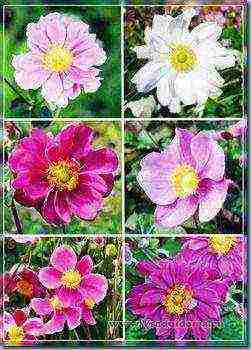
- Flowers with silky pink petals, reminiscent of ruffles, are characteristic of the anemones of the Hupei variety Septembercharme (September charm).
- Wirbelwind (Anemone japonica - Japanese anemone) captivates with flowers with white, often curved, like propeller blades, petals. This variety with long-lasting flowers is especially good for cutting.
- The pink-red semi-double flowers are the hallmark of the new, densely flowering variety of Japanese anemone Margarete (Margaret).
- The edges and the underside of the petals of the late-flowering hybrid of the Japanese Rosenschale anemones are tinted darker.
- Two colors, pink and purple, combine the flowers of the Japanese Bowles Purple anemone.
- The deep pink double flowers of the Japanese Bressingham Glow anemone adorn the garden in August - October.
Anemones are the most beautiful varieties
| The best varieties of anemones | ||
| Plant name | Description / height of the bush | Flowering period |
| Anemone hupehensis ‘Ouvertuere’ | petals are light pink with a purple tint below. Blooming profusely, resistant / 80-110 cm | July - September |
| Anemone hupehensis ‘Praecox’ | flowers are simple, crimson-pink. Abundantly flowering compact bushes / 60-80 cm | July - September |
| Japanese Anemone (Anemone japonica) 'Rotkaeppchen' | red-pink, bowl-shaped flowers. Branched, low bushes / 60 cm | August - October |
| Japanese Anemone (Anemone japonica) Andrea Atkinson | white simple flowers, branched variety, strong stems / 80 cm | August - October |
| Japanese Anemone (Anemone japonica) Koenigin Charlotte (Queen Charlotte) | classic variety, semi-double pink flowers, purple underside / 60-90 cm | August - October |
| Anemone tomentosa ‘Robustissima’ | tall variety, light pink flowers, bushy form / 120 cm | August - October |
| Japanese Anemone (Anemone japonica) ‘Rosenschale’ | new large-flowered variety, dark pink petals, one tone darker underside / 80-100 cm | September October |
| Japanese Anemone (Anemone japonica) 'Prinz Heinrich' | double flowers with narrow crimson-red petals / 90-120 cm | September October |
Below are other entries on the topic "Cottage and garden - do it yourself"
404: not found: We apologize to you ... When to plant plants and seedlings outdoors: Table: When to plant seedlings outdoors ... do not ... How to disable ad blockers on our website (AdBlock and others): You have repeatedly requested such requests ... How to process grapes - preparations (table): Preparations for processing grapes Wine growers know ... Key indicators of growing seedlings: Instruction for growing seedlings - ...
Subscribe to updates in our groups.
Let's be friends!
The anemone flower is better known in Russia as the anemone. It is also a genus of 120 species of flowering plants of the buttercup family, native to the temperate zone. If you believe the Oxford English Dictionary, then anemone in the lane. from Greek literally translated as "daughter of the wind." In Ovid's Metamorphoses it is said that the flower was created by the goddess Venus when she sprinkled nectar on the grave of her lover Adonis.
Such a romantic story of the origin of anemone flowers adds mystery to them. The popularity of the plant is given by the widespread prevalence in forests of anemones, which delight the eye as primroses that bloom shortly after the snow cover melts.
Description of the anemone plant with photo
Anemone flowers are a long-stemmed perennial with leaves that are either prostrate or erect. They stand out for their jagged and sometimes solid edges. In the photo, the anemone is shown in a general plan and various parts of the plants.
An umbrella of 2-4 flowers contains from 4 to 27 sepals, which can be absolutely any color. The pistil has one egg. There are also nectarines inside the flower.
The fruits of the anemones look like a nut and can be either slightly pubescent or completely naked. Devices are often found that allow the flower to spread in a gust of wind.
Anemones varieties
Currently, there are about 150 known species and varieties of Anemones. We will only tell you about a few representatives.
Noble coppice (Anemone hepatica)
Anemone hepatica is native to the northern hemisphere. The flower reaches up to 12 centimeters in height, and the leaves and the flower appear directly from the rhizome (and not from the trunk, as we are usually used to). The upper side of the leaves is dark green, while the underside is reddish brown or purple. They appear during flowering and retain their color throughout the winter. Flowers of this variety of anemones also appear in winter, they can be white, pink, blue or purple.
Baikal anemone (Anemone baicalensis)
Anemone baicalensis is distributed in areas where forests, shrubs and other similar herbaceous areas grow. The main habitat of the Baikal anemone is Siberia, Mongolia, North China and Korea. It has a lot of greenery and small white flowers.
Canadian anemone (Anemone canadensis)
Anemone canadensis or Canadian anemone is native to the lake shores of North America. Shoots with deeply divided and toothed leaves grow on long, thin rhizomes. Each flower has an average of five sepals and many stamens, which bloom from late spring to summer on stems just above the leaves. For a long time, peoples living in North America have used the plant as a hemostatic agent for wounds, nosebleeds and ulcers. Sometimes they even had their eyes washed. We strongly recommend that you be careful when working with this species, as anemone flowers have been proven to contain substances that can irritate your skin.
Anemone caroliniana
Anemone caroliniana grows up to one and a half meters tall and has very short tubers. The flower, consisting of 110-20 sepals of white or delicate pink color, begins to bloom from the very beginning of spring. Sepals are usually up to 25 mm long and up to 5 mm wide. In the center, an egg-shaped fruit grows up to one and a half meters in volume. The anemone is found in dry and rocky regions of the north south-central and southeastern United States (Carolina, South Dakota, Tennessee, Texas, and Wisconsin).
Anemone drummondii
Anemone drummondii is a wildflower native to North America. This squat flower has a very short stem and small, soft leaves. The flower has very showy white sepals with a slight shade of blue. There are yellow stamens and fruits - woolly achenes. The plant takes root well in the conditions of rocky mountains and coniferous leaves.
Anemone multifida
Anemone multifida is significantly different in size from other species. The height of the flower can reach up to 70 cm, and the entire surface of the leaves twenty centimeters long is covered with white hairs, sometimes coarse and sometimes soft. In an inflorescence there can be from one to several flowers - the number is not limited, and colors, by the way, can also be any. The center of the flower contains up to 80 stamens. The fruit is a hairy achene several millimeters long.
Japanese terry anemone de Caen
Contrary to many misconceptions, anemone de Caen is not a terry variety. The plant has a rather high and stable stem, the length of which can reach 70 cm with proper agricultural technology. A flower with simple petals. Differs in long flowering, resistance to adverse environmental conditions. The flowers of the de Caenne anemone exude an amazing aroma. Suitable for growing at home.
Terry anemone is a highly ornamental plant with a long flowering period.Depending on the subspecies, it can bloom throughout the summer and into late autumn. It is used in group compositions, decoration of alpine slides, for rockeries and potted crops.
Japanese anemone is also a terry variety. It is a hybrid with the original use of wild material. As a result of long-term selection, varieties with a rich burgundy and bright red color were bred. This type of terry anemones can be successfully used in decorative floriculture. It is often planted in a pot culture.
Conditions for growing anemones
If you ensure that the anemones are properly grown, then some types of flowers can provide flowering throughout the season. To do this, it is enough to plant different varieties in one group. For example, Anemone nemorosa and Anemone blanda (forests and alpine meadows) thrive best in spring; in spring and summer - Anemone coronaria (hot dry room); summer and autumn - Anemone hupehensis (humid room, in partial shade).
Anemones grow best in loamy soil, enriched with well-rotted manure, which, by the way, should be below the flower tubers. The ideal option is a drained, slightly acidic soil, enriched with compost. The plant will grow remarkably only in partial shade or full sun, provided they are well protected from the hot southern sun. Follow these rules for growing anemones and you will get guaranteed excellent results. In the meantime, we offer you a photo of anemone flowers:
Planting anemones and caring for flowers
Planting anemones can begin in early October or January. It will begin to bloom in April - May. As soon as the leaves begin to bloom on the anemones, it must be immediately placed in a dry place for ripening. In a warm room and with properly planted seeds, it produces beautiful and shiny white flowers, somewhat reminiscent of a snowdrop or crocus. Caring for anemones should be carried out throughout the growing season.
During the growth of the green part of the plants, feeding should be carried out with a predominance of nitrogen and organic matter. During the setting of flower stalks and during flowering, complex mineral fertilizers with a high percentage of potassium, manganese and phosphorus help to prolong this splendor. Organic matter should be applied annually in autumn and spring in the form of mulching the topsoil for subsequent loosening.
The soil should be loosened very carefully and carefully, since the roots of the anemone are fragile and break easily. Watering should be regular. In the spring, this should be done at least once a week. In hot weather, watering should be daily, preferably in the morning or evening after sunset.
But it is best to transplant anemone flowers in early spring - at the time of the emergence of sprouts, it is transplanted into a more fertile and loose soil.
Four ways to reproduce anemones - using seeds, dividing the bush, parts of rhizomes and tubers.
The main diseases and pests are leaf nematodes, larvae, etc. In case of severe infestation, the plant should be removed completely and the soil should be changed in this place.
source
6 january 2017 Flowers Alienteu
An ancient Greek legend says that an anemone grew out of the tears of Aphrodite mourning her murdered lover. Beautiful legend, beautiful and garden anemone flower. Literal translation from ancient Greek - "daughter of the winds." In Russia, the anemone (pictured) is better known as the anemone - apparently because at the slightest gusts of wind, the peduncles begin to sway, and the petals flutter, and sometimes fall off.
Botanical description
Anemone (lat.Anemone) is a perennial plant belonging to the numerous Buttercup family. This herbaceous plant, tuberous or rhizome, includes more than 150 species. The height of the stem, depending on the species, ranges from 10 cm to 1 meter (there are varieties whose peduncle height can reach 1.8 meters).
The leaves are either separate or finger-dissected. Some consider them rude, but this, as they say, is not for everybody. Their decorative effect is beyond doubt.
Flowers of anemones can be either single or in semi-umbellate few- or multi-flowered inflorescences.Perianths with 5-20 leaves can have different shapes - in some varieties they resemble poppy flowers, in some - chamomile. Flowers are radially symmetrical, bisexual. The color of anemone flowers ranges from white, blue, pink, yellow to blue, red, purple and even green.
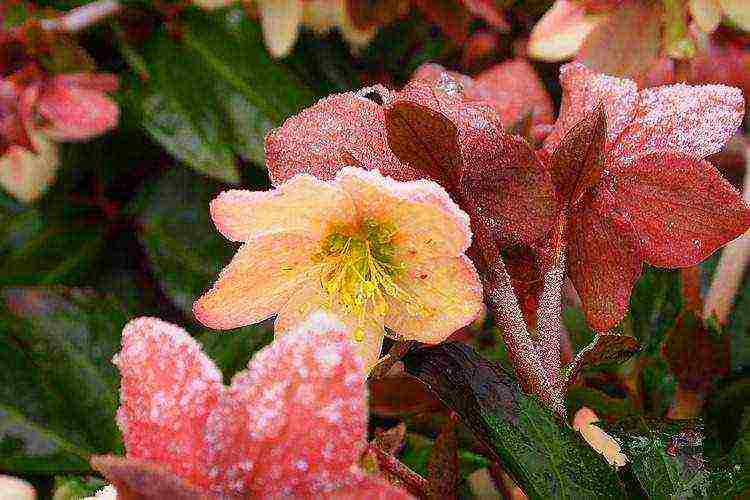
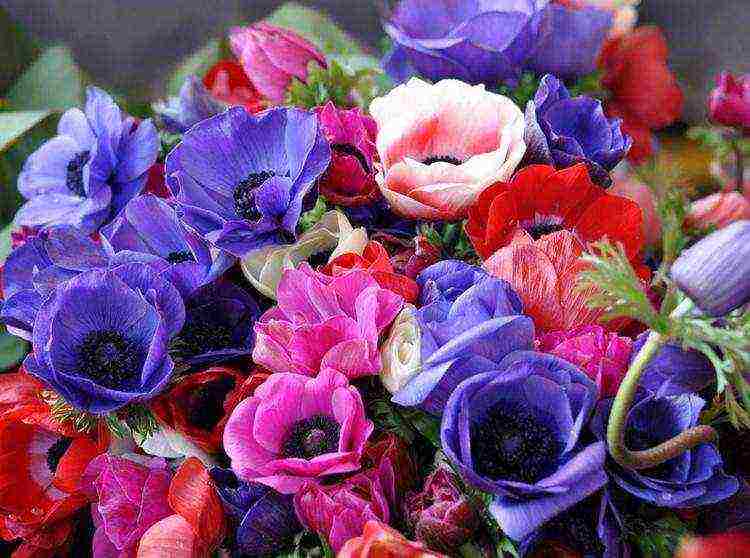
Anemone grows almost everywhere in the temperate climate of the Northern Hemisphere. Several species grow even in the Arctic - in the north of Russia, Canada, Alaska and Norway. The growing environment is deciduous forests, mountain slopes, alpine valleys, subalpine and steppe meadows, the lower part and grassy mountain slopes, mountain tundra.
Classification
The scientific classification of anemones for a layman is complex, confusing and hardly interesting. Here it will be given in a simplified and somewhat modified version, understandable to any amateur gardener.
Bloom time grouping
Ephemeroids - the earliest flowering, the growing season is very short - the plant blooms, fades, its leaves dry up and it hides under the ground until new spring. For example:
- anemone tender;
- oak anemone;
- anemone is flexible;
- Amur anemone;
- buttercup anemone;
- anemone is shadow.
Summer blooming anemones:
- anemone canadian;
- forest anemone;
- multi-cut anemone;
- anemone Drummond;
- forked anemone.
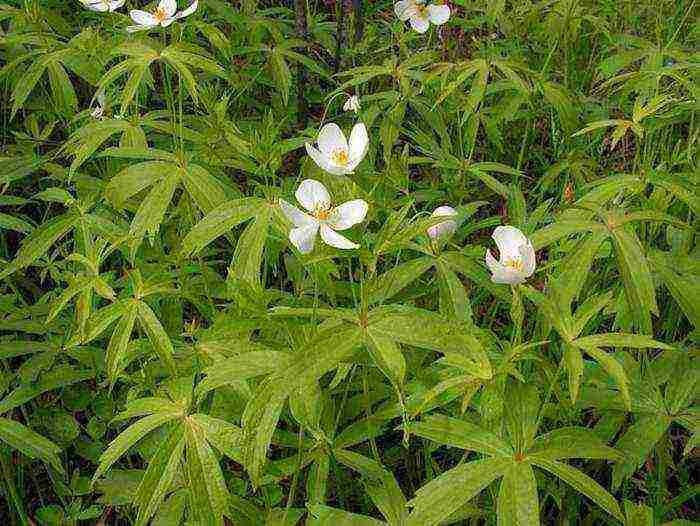
Forked anemone
Perhaps this group includes the most resistant and hardy plants. They are better than other anemones at adapting to changes in lighting conditions.
Anemones blooming in autumn:
- Japanese anemone;
- Hubei anemone;
- felt anemone;
- hybrid anemone;
- crown anemone.
Autumn anemones grow well, are relatively unpretentious.
Grouping by type of rhizome
Long jointed rhizomes - mostly ephemeroids.
Tuberous rhizomes... In plants with such rhizomes, the flowers are single, the growing season is short:
- anemone apennine;
- Caucasian anemone;
- crown anemones;
- tender anemone (anemone blanda);
- anemone garden.
Short straight thickened rhizomes... Umbrella inflorescences, growing season - all season:
- long-haired anemone;
- cluster anemone.
Rhizomes forming root suckers... Rhizomes are powerful, growing season - all season:
- forked anemones;
- canadian anemones;
- anemones are forest.
All of the above-described anemones winter well in Central Russia. The exception is crown anemones, they require careful shelter or digging for the winter.
Planting anemones
It is important to find a suitable area in the garden for growing anemone. Before planting anemones in open ground, you need to make sure that we have chosen the right place for planting - the requirements for growing conditions differ significantly from species to species. Among the anemones there are shade-loving, shade-tolerant and light-loving.
Shade-loving anemones are represented by ephemeroids. They all bloom in early spring. They should be planted on the north side of the site or under the crowns of trees.
Shade tolerant anemones: canadian, forest, forked, flexible, Amur, forest. In our conditions, they grow in partial shade or under trees with an openwork crown.
Photophilous anemones: Caucasian, Apennine, tender, crown. In Russia, they do not have enough light, so when planting this must be taken into account and planted on the southern slopes.
Without exception, all anemones do not like drafts - this must also be taken into account when choosing a place for planting.
Let's talk about the features of the landing. Anemone loves loose, light, moderately fertile soil. Absolutely does not tolerate acidified soils. Before planting, it is good to add organic fertilizers and ash or dolomite flour to the soil to deoxidize the soil.
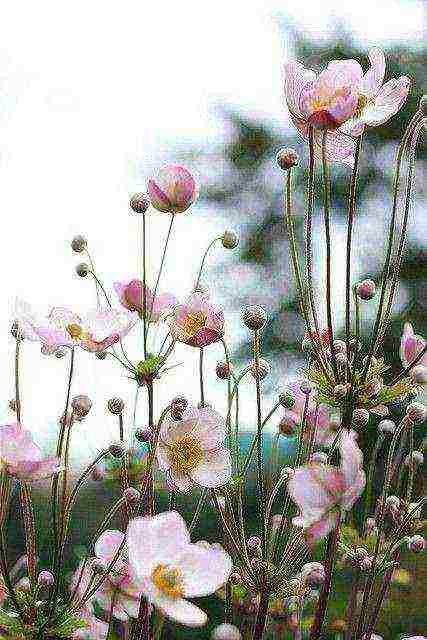 All rhizome anemones, except for ephemeroids, must be transplanted and planted in the spring, when the first shoots hatch. Ephemeroids are transplanted at the beginning of summer, when the aboveground part of the plants is already well dried.
All rhizome anemones, except for ephemeroids, must be transplanted and planted in the spring, when the first shoots hatch. Ephemeroids are transplanted at the beginning of summer, when the aboveground part of the plants is already well dried.
Another significant point. Planting the delicate and fragile roots of the anemone can be traumatic.Therefore, anemones must be planted very carefully and at some distance from each other and other plants.
Anemones grown from a tuber are planted in open ground in early spring or late autumn. Before planting, anemone tubers must be soaked in warm water for several hours until they swell. It is good to add "Epin" or "Zircon" to the water. It is necessary to plant in a pot with a mixture of sand and peat or directly into the ground to a depth of 5 cm. If the growth buds are clearly visible, we direct them up when planting, if not, we direct the sharp tip of the nodule down. When in doubt about how to position the tuber correctly, lay it on its side. And, of course, you only need to buy healthy bulbs.
Forest anemone can grow on poor sandy soils.
Water the planted plant well. After watering, it is advisable to mulch the planting site with a layer of leaves, peat or decorative mulch, which is sold in abundance in garden centers.
Seed propagation
Seed propagation is difficult due to poor seed germination. In the best case, they get 25 percent of the seedlings, and they still need to grow up to planting in a permanent place. Only ephemeroids reproduce by self-seeding, and even then not all. Forest anemone reproduces best by self-seeding.
Only freshly harvested seeds are suitable for seed propagation. The easiest way is to sow seeds in late autumn in boxes filled with loose soil, cover with moss and bury the boxes in the ground in the yard. For the winter, cover with spruce branches or leaves of fruit trees. Under such conditions, the seeds will undergo natural stratification and sprouting will appear next spring.
Planted seedlings of rhizome varieties must have at least two strong leaves. In tuberous varieties, they wait for the leaves of the seedling to dry out, dig up the nodules and store them until autumn in a well-ventilated room.
Vegetative propagation
It is carried out in the spring, when the first shoots appear on the soil surface. We carefully dig out the plant, cut off a piece of rhizome with renewal buds and plant it in a permanent place horizontally, water it. Vegetative propagation can be done at the same time as transplanting.
In the anemone, which forms root suckers, at the beginning of the growing season, carefully dig out a piece of rhizome with a bud of renewal, cut it off with a sharp knife or pruner and transplant it to a permanent place.
By dividing the bush, varieties with a vertical rhizome are propagated. There should be 2-3 renewal points for each division.
It should be borne in mind that the anemone does not like transplants very much, so it is better not to disturb it without special need. It is easiest to propagate varieties that bloom in autumn.
Anemone care
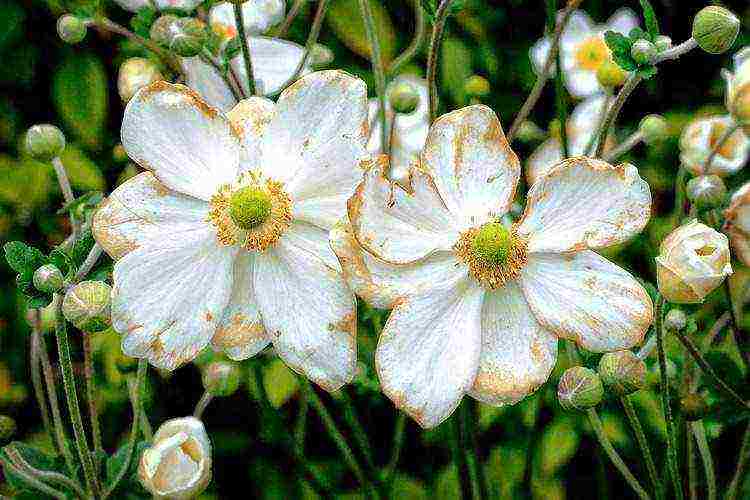
Although planting an anemone in open ground (photo) presents some difficulties, caring for it is simple if you strictly adhere to some rules. Observe them, and it will be easy and pleasant to care for the anemone.
Watering
Watering is the most important and crucial moment in caring for an anemone. Excess moisture can be detrimental to the plant, but moisture is still needed, especially at the time of bud formation. The way out is well-drained soil and mulching. In the spring, if there is no rain, it is enough to water once a week.
If it is not very hot in summer and sometimes it rains, you do not need to water at all. If the weather is hot and dry, the anemone should be watered daily, if possible, very early in the morning, if not - after sunset. The exception is the crown anemone - it needs watering for the entire flowering period, regardless of the weather.
Top dressing
It is important to know that during the planting of anemones, organic fertilizer is laid in the ground, while during flowering, fertilizing is carried out with mineral fertilizers. If the soil was well filled with organic matter in the fall or spring, then you can skip top dressing in the summer.The exception is, again, the crown anemone, especially if it is grown for a cut - it must be fed during flowering. Anemone doesn't like fresh dung!
Seasonal care
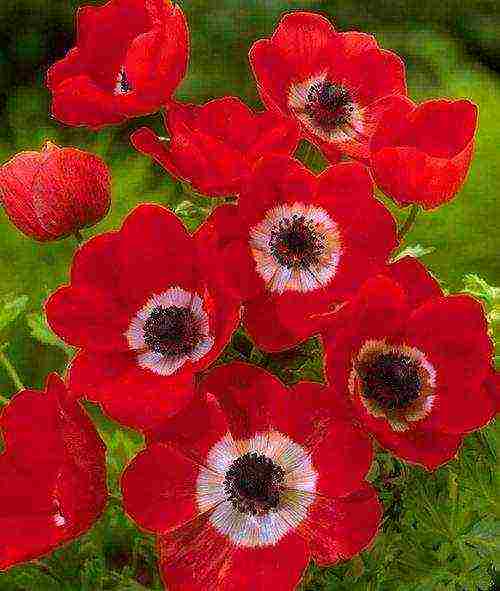 In early spring, transplants are made, planting of new plants and tubers that were not planted in the fall. Also, if necessary, watering is carried out, but not more often than once a week. Collect seeds of spring varieties if you are going to seed propagation.
In early spring, transplants are made, planting of new plants and tubers that were not planted in the fall. Also, if necessary, watering is carried out, but not more often than once a week. Collect seeds of spring varieties if you are going to seed propagation.
In summer, care consists in regular weeding, and this must be done very carefully so as not to damage the root system. Water if necessary. Collect the seeds of summer blooming anemone if you are going to seed.
In the fall, it is necessary to prepare the plants for winter. Dig up tubers of non-wintering or poorly wintering varieties, cut off the aerial part, dry and store until spring in a dry, cool, well-ventilated room. It is good to place the tubers in sand or peat. Cover rhizome plants and tubers that hibernate in the ground with a thick layer of mulch. It is best with a well-rotted mullein, if this is not possible, then with the leaves of any fruit trees. Also, don't forget to collect the seeds.
Check stored tubers from time to time in winter.
Perhaps the easiest anemone to plant and care for is Japanese.
Pests and diseases
Sometimes the plant is affected by a nematode - while yellowish spots appear on the leaves, eventually darkening. It is best to destroy the plant immediately, replace the ground under it. If aphids appear, spray the plant with a solution of laundry soap or any aphid remedy and fight the nests - most likely the aphids were brought in by the ants. But the biggest danger is overflow - the plant can get sick with root rot and die.
Anemones in landscape design
Healthy and well-groomed anemones look fantastic. And although their flowering is not very long compared to garden annuals, rarely a flower can compare with their exquisite beauty.
Low-growing anemones, such as forest and oak anemones, are often used to decorate the space in front of shrubs or around trees with an openwork crown. They look especially impressive, planted in large tracts as "undergrowth" in large areas. The paths bordered by these plants look simple and beautiful.
Virginia anemone is suitable for decorating the shore of a reservoir.
Japanese anemone, planted in small dense groups among green shrubs and low trees, will revive and complement the composition. They are good next to peonies, phloxes and osteospermum, which you can learn more about here.
Early flowering anemone varieties look great with muscari and primrose.
And, probably, it is difficult to imagine a place in a garden or a flower garden where crown anemone, represented by popular varieties with simple flowers: De Caen anemone, Bicolor anemone, Mister Fokker and Sylphide anemone, would not be appropriate.
And, of course, terry anemone is the plant, planting which you add charm to your site. Some of the popular representatives of this flower are the Lord Lieutenant, Saint Bridget and Don Juan anemone.


